SATREPS (Science and Technology Research Partnership for Sustainable Development)
http://www.jst.go.jp/global/english/
The Global Innovation Summit 2012 (GIS) took place in San Jose, the center of America‘s Silicon Valley, organized by T2 Venture Capital. Sponsors included the United States Agency for International Development (USAID), the World Bank, the African Development Bank (AfDB), the Inter-American Development Bank (IDB), the Lemelson Foundation, and the Kauffmann Foundation. The GIS Advisory Board included professor Kiyoshi Kurokawa, former President of the Science Council of Japan. JST (Japan Science and Technology Agency) participated in GIS as an Institutional Partner and was represented at the Summit by 3 delegates from SATREPS and the JST Washington, D.C. Office. In addition, members of two SATREPS Environment and Energy projects in Africa attended the Summit to join in panel discussions and make presentations about their projects. Their project booths attracted people such as social entrepreneurs and were the scene of keen discussions, providing an excellent opportunity to network on the global level and discover a range of perspectives on how to turn research results into viable businesses. One of the specific aims of the SATREPS program is for research outcomes in developing countries to contribute to the wider community, so the Summit was extremely valuable in this respect. SATREPS made a significant mark on the Summit by demonstrating that Japan‘s policies are already bringing success through inclusive innovation that includes active collaboration with developing countries. It was gratifying to see that other delegates rated SATREPS highly, and to be approached by so many people wanting to know more about SATREPS and SATREPS projects.
The 3-day Global Innovation Summit took place on July 16-18 in the heart of Silicon Valley, home to IT giants such as HP, Apple, and Google, and to countless startups and venture capitalists. It was a first-of-its-kind initiative, attracting government agencies, financial institutions, and other major development organizations from around the world to collaborate with Silicon Valley innovation experts. About 400 participants from 49 countries participated, representing a large variety of stakeholders, and generating lively debate on how to cultivate new innovation in developing countries. The main theme of the Summit was "Cultivating Innovation Ecosystems." Taking a cue from case studies of research in Silicon Valley, the organizers applied their "Rainforest" model and structured the Summit to encourage organic, global networking with research institutions, venture capitalists, markets, and corporations.
"Improving Sustainable Water and Sanitation Systems in Sahel Region in Africa" is a SATREPS project headed by Prof. Naoyuki Funamizu of the Graduate School of Engineering, Hokkaido University in Japan and based on collaboration between Japanese researchers and researchers at the International Institute for Water and Environmental Engineering (2iE) in Burkina Faso. This project aims to create new business models to apply the social innovation of supporting agriculture through the introduction of composting toilets. In addition to researchers from Hokkaido, we invited three engineering students from 2iE to join in with presenting the project at the Summit. In a panel discussion, Prof. Funamizu described his ideas for new water and sanitation system business models as a case study of a social enterprise, attracting a lot of questions and comments from the audience. In particular, there was strong support for the way that the project had begun the research by identifying local needs from the perspective of toilet system users, utilizing sociological surveys and other approaches. The project booth was busy every day, discussing ideas with BOP (base of the economic pyramid) business experts.
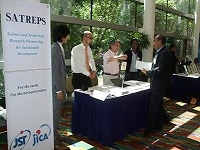
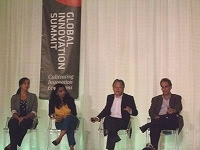
<photos>
Left: Visitors to the Burkina Faso project booth included social entrepreneurs.
Right: Prof. Funamizu‘s panel
"Prediction of Climate Variations and its Application in the Southern African Region" is a SATREPS project aiming to enhance the technology for predicting climate variations, and use the outcomes of the research to mitigate the effects of abnormal climate in Southern Africa. The project is led by Toshio Yamagata, director of the Japan Agency for Marine-Earth Science and Technology (JAMSTEC) Application Laboratory, with his team of researchers in Japan working with partners in South Africa. At the Summit, JAMSTEC researchers were joined by entrepreneurs from JAMSTEC‘s first startup, Forecast Ocean Plus Inc. Each day, they welcomed visitors to the project booth, explaining the model they had devised for predicting climate variations, and actively making and building on contacts in preparation for utilizing the model in business in developing countries. The project team was approached by funding bodies and social enterprise consultants, and the booth became the center of some very lively discussions.
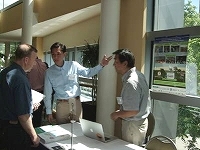
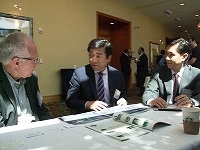
<photos>
Visitors to the South Africa project booth included social enterprise consultants.
On the final day of the Summit, JST delegate/SATREPS director Shigeo Okaya took part in the "Accelerating Ideas to Markets" panel discussion. The audience was surprised to hear that through SATREPS, Japan is already working in partnership with developing countries to create pipelines for innovative ideas, connecting to entrepreneurs and other market players. That comment sparked excited discussion, including remarks about involving developing countries in inclusive innovation—the country‘s commitment is vital, and that is not going to occur if there are only unilateral efforts by developed-country companies and institutions—and about innovation occurring in the context of a deep relationship of trust on a global scale—there is no need for all the stakeholders to be located in the same region.
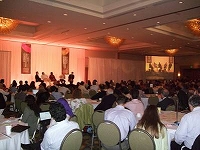
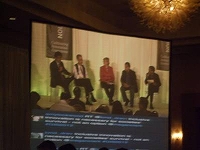
<photos>
Left: Summit sessions had screens displaying close-ups of the panelists with live Twitter feeds.
Right: SATREPS director Shigeo Okaya speaking on the "Accelerating Ideas to Markets" panel
Hiroshi Inomata, the Consul General of Japan in San Francisco, visited the Summit to meet GIS Executive Chairman Al Watkins and the Japanese participants, expressing his pleasure at there being such a large Japanese presence at this sort of global development conference. His encouragement seemed to boost the motivation of everyone on the Japanese team. As a member of the delegation, I personally gained a renewed commitment to the SATREPS mission—For the Earth, For the Next Generation.
Mayuko Totsuka, SATREPS
Note 1: Inclusive innovation—A strategy of focusing on the potential of developing countries in particular, and involving developing country people in the process of innovation.
Note 2: Rainforest model—The rainforest model is based on the idea that culturing innovation requires an appropriate ecosystem, just as the rainforest provides a fertile ecosystem for new species. To cultivate innovation by providing such an ecosystem, the rainforest model attempts to create organic, global networking opportunities between stakeholders with diverse roles.
<Links>
The Global Innovation Summit
http://www.innosummit.com/
SATREPS project: Improving Sustainable Water and Sanitation Systems in Sahel Region in Africa: Case of Burkina Faso
http://www.jst.go.jp/global/english/kadai/h2112_burkinafaso.html
SATREPS project: Prediction of Climate Variations and its Application in the Southern African Region
http://www.jst.go.jp/global/english/kadai/h2103_southafrica.html
SATREPS
http://www.jst.go.jp/global/english/
SATREPS (Science and Technology Research Partnership for Sustainable Development) is a Japanese Government program that promotes international joint research targeting global issues. Funded jointly by Japan Science and Technology Agency (JST) and the Japan International Cooperation Agency (JICA), SATREPS works through three- to five-year projects involving partnerships between researchers in Japan and researchers in developing countries. There are currently 66 SATREPS projects in 34 countries
JST, an integrated organization of science and technology in Japan, establishes an infrastructure for the entire process from the creation of knowledge to the return to the society. For more information, visit http://www.jst.go.jp/EN/